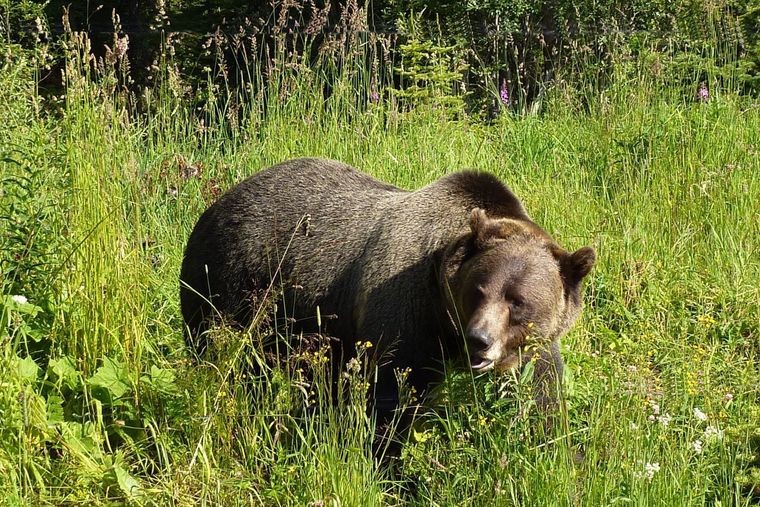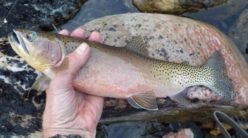Recently, a reader e-mailed me some questions about a column I wrote during the first part of 2016 about finding bears in Yellowstone National Park.
I immediately reviewed the 2016 column and decided that the information in that column was still pretty accurate. However, I have continued to visit Yellowstone to see the wildlife, including bears, and I’ve learned more than I knew last year.
The particular reader I mentioned was mostly interested in the most likely places to see grizzly bears, so this column will kind of mirror the response I sent him.
First of all, the park rangers do what they can to discourage bears from hanging around the roads in Yellowstone. In addition, the city dumps in West Yellowstone and other locations around the park have been eliminated. That is why fewer bears are seen along the roads in Yellowstone and most of the bears that visitors do see are best viewed with binoculars or spotting scopes.
Secondly, if you do decide to go hiking on the trails in Yellowstone, hoping to see bears, be sure to travel in a group and talk, sing or make noise so bears and other wildlife will hear you and there won’t be any surprise encounters. Park officials and others often recommend having bear spray and a cow bell, which can definitely be heard quite a ways away by wildlife. I will admit that I personally do not wear a cow bell when hiking in Yellowstone, but I do like to travel in a group and talk with others as I hike. I also carry the bear spray, which is recommended by most park officials.
Do I need to mention that it is a very bad idea to try and get close to any wildlife in Yellowstone? The past couple of years have seen numerous people getting hurt and sometimes killed because they got too close to bison, bears and other wildlife in the park.
Both black bears and grizzlies can be spotted in most areas of the park by those with sharp eyes, a willingness to be patient and at least a good pair of binoculars. My binoculars are 12-power and have served me well at ranges of several hundred yards. Most of the professional researchers that are working in the park have spotting scopes and set up in areas that are known for bears.
If I am looking for bears in the Lamar Valley, the trailhead for Trout Lake with a parking area is just a couple of miles west of the Pebble Creek Campground on highway 212. The hike up to Trout Lake is pretty steep, but those in good condition can make the climb in about 20 to 30 minutes. The area is remote, pristine and a decent place to see bears. If there are others wandering around the area, the bears may avoid coming too close, so find a vantage point, plan on staying awhile and use your binoculars to spot them.
Another place we have seen grizzles in the Lamar Valley is along the Lamar River, across the road from the entrance to the Slough Creek Campground. There are practically no turn-offs along the road and park rangers can get a little surly whenever a crowd develops in this area, traffic gets blocked or people begin running up and down the road.
It is not in your best interests to argue with the park rangers. Just follow their instructions, which usually amounts to “get back in your car and move along.” My wife was scolded by a ranger for letting her kids run up and down the road in this area, and they weren’t even her kids. So the park rangers can get pretty frustrated, too.
The Slough Creek area is another place where you might see grizzlies, especially if you hike the old wagon trail to the Silver Tip Ranch on the northern border of the park.
The area just east of Roosevelt Junction and just north of Highway 212 is fairly flat, ending in a slight rise about 1,500 yards from the junction. We have seen grizzlies there on several occasions. A good spotting scope is nice to have when watching bears in this area.
The Dunraven Pass is another good area to see grizzlies for those who have sharp eyes and a driver that will keep his/her eyes on the road and let the passengers look up the mountain for bears.
Another area worth mentioning is the trail around Pelican Creek. The trailhead starts about 2 miles east of Fishing Bridge on the way toward the East Entrance to the park.
You may also be able to see bears between the East Entrance to the park and Pelican Creek.
If you are planning a trip to Yellowstone National Park this summer and can spend a few days camping and exploring the park, you will have a better chance of seeing bears during your visit even if you don’t see them every day. Just be smart, don’t get too close, be alert, be cautious, stay close to the established trails, travel in a group, make some noise and carry bear spray. That way you can have a great time and stay safe.
Smokey Merkley was raised in Idaho and has been hunting since he was 10 years old. He was a member of the faculty of Texas A&M University for 25 years. There he taught orienteering, marksmanship, self-defense, fencing, scuba diving and boxing. He was among the first DPS-certified Texas Concealed Handgun Instructors. He can be contacted at mokeydo41245@hotmail.com.



